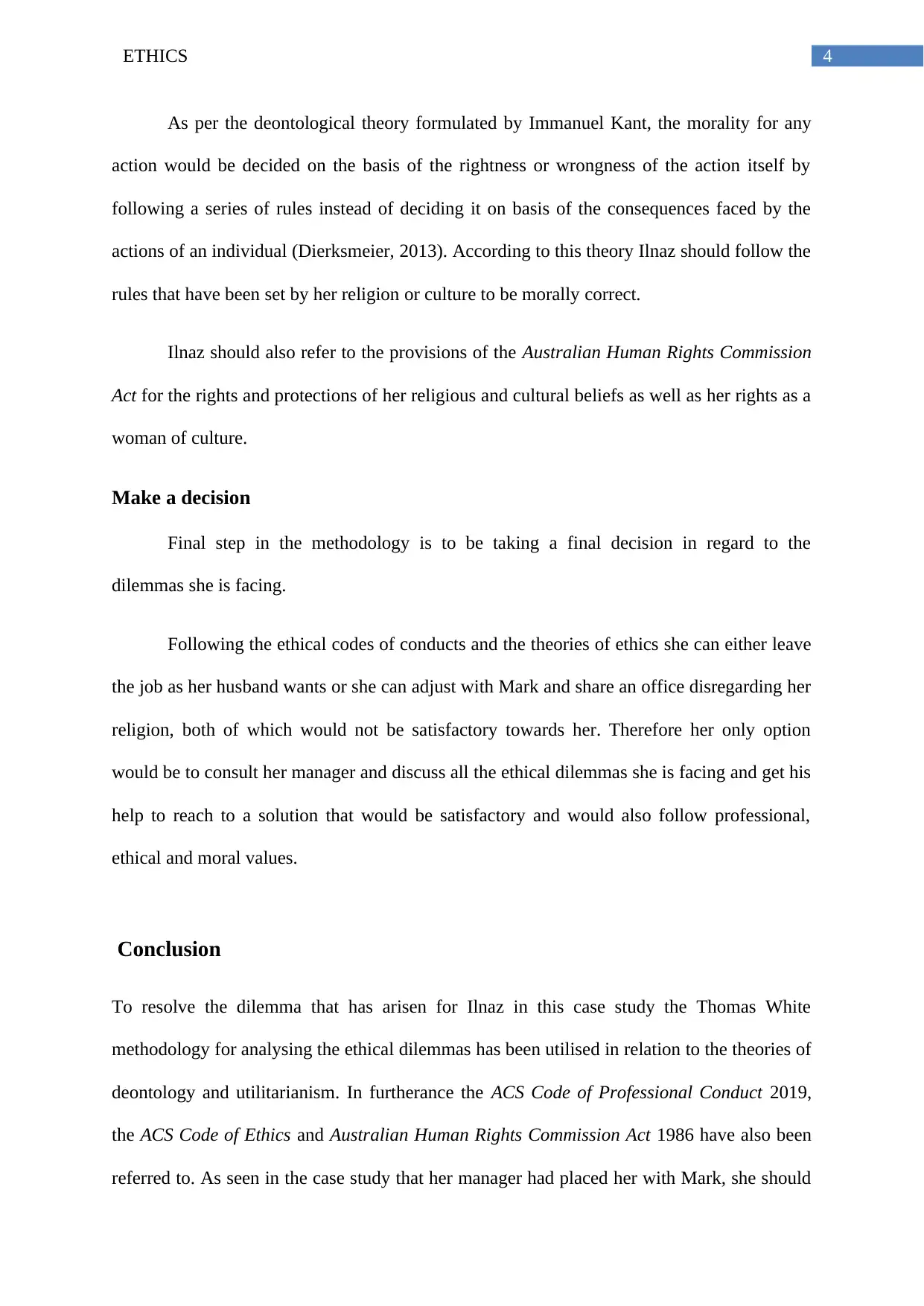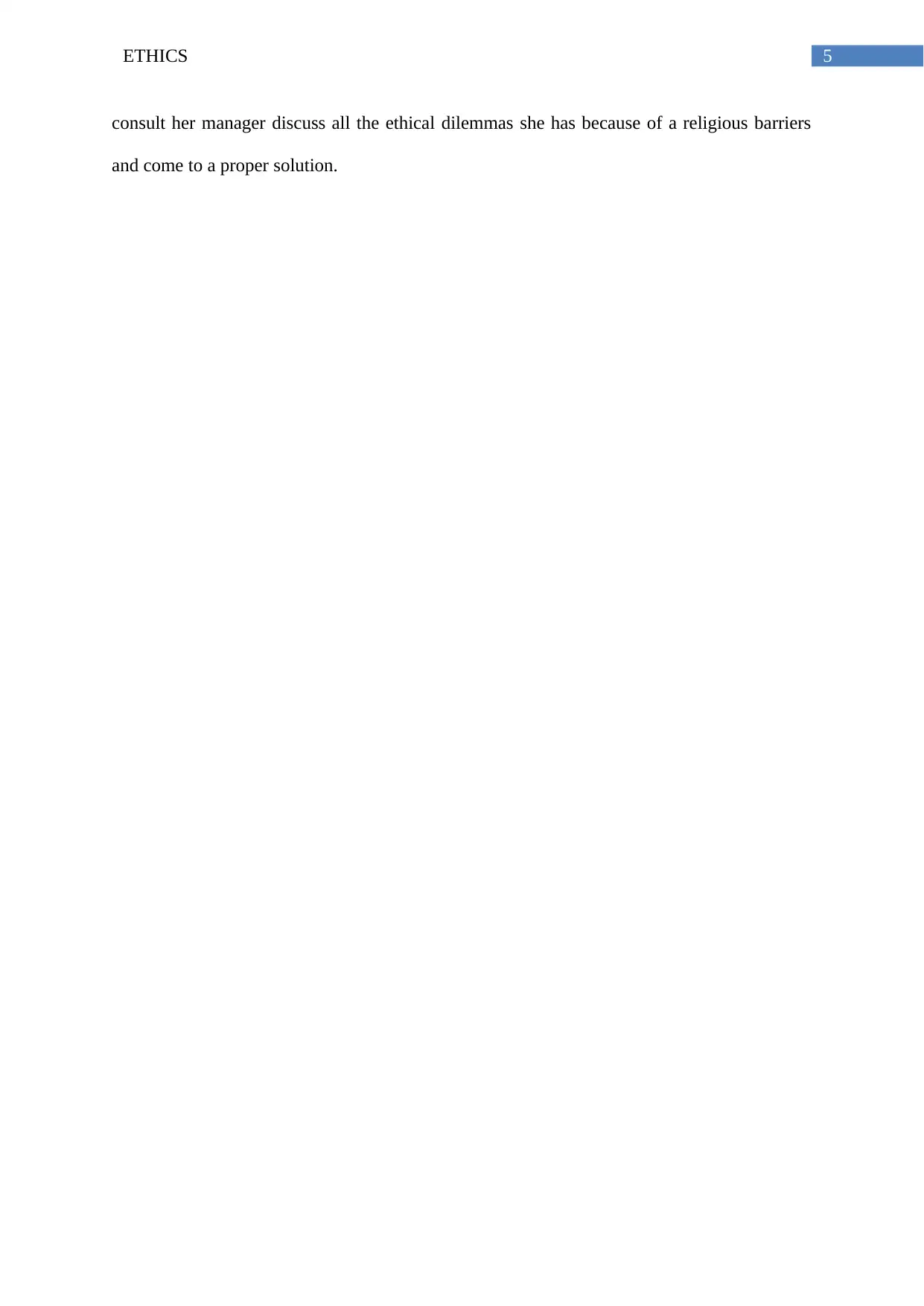Case Study: Ethical Dilemma of Ilnaz at CompuSoft - Ethics in Business
VerifiedAdded on 2022/10/10
|7
|1388
|325
Case Study
AI Summary
This assignment analyzes the ethical dilemma faced by Ilnaz, a 22-year-old married woman from Iran, working as a manager at CompuSoft, an Australian company. The core issue revolves around her manager's decision to place her in a shared office with a male colleague, which conflicts with her religious and cultural beliefs, and causes distress for her and her husband. The analysis employs Thomas White's methodology, including analyzing the consequences of her actions and the actions themselves, referencing the ACS Code of Professional Conduct 2019, ACS Code of Ethics, and the Australian Human Rights Commission Act 1986. The assignment also applies the theories of utilitarianism and deontology to provide a comprehensive ethical framework. The solution proposes that Ilnaz should consult her manager to find a solution that respects both her professional and personal values. The assignment concludes by emphasizing the importance of ethical considerations in the workplace, particularly when cultural and religious factors are involved.

Running head: ETHICS
ETHICS
Name of Student
Name of University
Author Note
ETHICS
Name of Student
Name of University
Author Note
Paraphrase This Document
Need a fresh take? Get an instant paraphrase of this document with our AI Paraphraser

1ETHICS
Introduction
In the recent case study an analysis has been done about the ethical dilemmas faced
by Ilnaz in relation to her work. In the given scenario it is seen that Ilnaz is a 22 year old
married women from Iran. She got the job as the manager of an Australian Company named
CompuSoft, which can be seen as specialising in in DVDs. It is seen from the given facts that
Her manager had placed her in a single office with a male colleague named Mark because
both of them would be working on the same project and according to the manager it would be
helpful for them to share and office learning from each other and working together. Ilnaz can
be seen under an ethical dilemma the arrangement of sharing an office with Mark would be
against the beliefs of the religion and culture she follows where it is against values of any
married woman to be in complete isolation with any unrelated man. Even her husband is seen
as being visibly upset and he had further threatened to stop working. To resolve the dilemma
that has arisen in this case study the Thomas White methodology for analysing the ethical
dilemmas has been utilised in relation to the theories of deontology and utilitarianism. In
furtherance the ACS Code of Professional Conduct 2019, the ACS Code of Ethics and
Australian Human Rights Commission Act 1986 have also been referred to.
Thomas White Methodology
An ethical dilemma was seen to be arising for Ilnaz. For resolving the dilemma Ilnaz
can be referring to the methodology proposed by Thomas White for resolving ethical delivers
arising certain situations. A three step process is followed for reaching in a decision in case of
a ethical dilemma in this methodology (White, 2013).
Introduction
In the recent case study an analysis has been done about the ethical dilemmas faced
by Ilnaz in relation to her work. In the given scenario it is seen that Ilnaz is a 22 year old
married women from Iran. She got the job as the manager of an Australian Company named
CompuSoft, which can be seen as specialising in in DVDs. It is seen from the given facts that
Her manager had placed her in a single office with a male colleague named Mark because
both of them would be working on the same project and according to the manager it would be
helpful for them to share and office learning from each other and working together. Ilnaz can
be seen under an ethical dilemma the arrangement of sharing an office with Mark would be
against the beliefs of the religion and culture she follows where it is against values of any
married woman to be in complete isolation with any unrelated man. Even her husband is seen
as being visibly upset and he had further threatened to stop working. To resolve the dilemma
that has arisen in this case study the Thomas White methodology for analysing the ethical
dilemmas has been utilised in relation to the theories of deontology and utilitarianism. In
furtherance the ACS Code of Professional Conduct 2019, the ACS Code of Ethics and
Australian Human Rights Commission Act 1986 have also been referred to.
Thomas White Methodology
An ethical dilemma was seen to be arising for Ilnaz. For resolving the dilemma Ilnaz
can be referring to the methodology proposed by Thomas White for resolving ethical delivers
arising certain situations. A three step process is followed for reaching in a decision in case of
a ethical dilemma in this methodology (White, 2013).

2ETHICS
Analysing the consequences
The first step under the Thomas White Methodology is to be analysing the
consequences for the actions that have been taken. Consequences can be seen as either
positive or to be as negative but of the consequence all aspects are needed to be analysed in a
critical way. After Ilnaz considers all the possible outcomes that can be predicted she is
required to be weighing both the positive and the negative consequences. The results arising
from these consequences would help her in making the final decision.
Analysing the actions
According to the methodology the next step is to be analysing the actions that have been
taken. For analysing the actions the provisions of the ACS Code of Professional Conducts and
the ACS Code of Ethics should be referred in relation to this case study. As per the ACS Code
of Ethics under the provisions of ACS Constitution all the ACS members are required to
follow certain society values. The values under the ACS Code of Ethics that Ilnaz is required
to follow are (Acs.org.au, 2019):
1. placing the public interest above any personal, sectional or business interest;
2. striving for the enhancement of the quality of life of the individuals who are affected by
the works off the members;
3. enhancing one's own professional development as well as the professional development it
off their colleagues and other staffs; and
4. encouraging professionalism by enhancing the societies integrity and respecting the
members.
The values of the ACS Code of Professional Conduct can be considered if the given case
study are (Acs.org.au, 2019):-
Analysing the consequences
The first step under the Thomas White Methodology is to be analysing the
consequences for the actions that have been taken. Consequences can be seen as either
positive or to be as negative but of the consequence all aspects are needed to be analysed in a
critical way. After Ilnaz considers all the possible outcomes that can be predicted she is
required to be weighing both the positive and the negative consequences. The results arising
from these consequences would help her in making the final decision.
Analysing the actions
According to the methodology the next step is to be analysing the actions that have been
taken. For analysing the actions the provisions of the ACS Code of Professional Conducts and
the ACS Code of Ethics should be referred in relation to this case study. As per the ACS Code
of Ethics under the provisions of ACS Constitution all the ACS members are required to
follow certain society values. The values under the ACS Code of Ethics that Ilnaz is required
to follow are (Acs.org.au, 2019):
1. placing the public interest above any personal, sectional or business interest;
2. striving for the enhancement of the quality of life of the individuals who are affected by
the works off the members;
3. enhancing one's own professional development as well as the professional development it
off their colleagues and other staffs; and
4. encouraging professionalism by enhancing the societies integrity and respecting the
members.
The values of the ACS Code of Professional Conduct can be considered if the given case
study are (Acs.org.au, 2019):-
⊘ This is a preview!⊘
Do you want full access?
Subscribe today to unlock all pages.

Trusted by 1+ million students worldwide

3ETHICS
1.2.1 Ilnaz is required to be placing Public Interest above the personal or sectional even
business interests. If any conflict in the interest or values arise she would have to give priority
to the interest of the public. The values that would be impacted by her work are required to be
recognised by Ilnaz.
1.2.2 Ilnaz is required for trying to be detecting and enhancing the life quality e of individuals
and she should further be considering her personal feelings, satisfaction, competence and is
further required to be controlling the feelings which would be affected by her work.
1.2.5 Ilnaz is required to encourage her colleagues to be enhancing their professional
development and she should increase her Awareness of the issues that would be affecting her
profession the relationship she would have with others in regard to her profession.
1.2.6 Ilnaz should be taking a calm and objective stance on her work, and should be facing all
types of diverse challenges in the workplace is further required focusing on the opportunities
available for advertisement, employment and remuneration considering the conditions on the
basis of skills and capacities of her colleagues without any kind of limitations.
Theory of utilitarianism has been proposed by Jeremy Bentham and John Stuart Mill.
This theory is a part of normative ethics that states that an action would be moral when and
the action results in the greatest amount of good for the maximum number of people.
According to the utilitarianism theory actions making individuals happy are moral and good.
The theory looks beyond personal interest of an individual can be taking the interests of the
society as a whole (Mill, 2016). Applying the utilitarianism theory in this case study Ilnaz
should be considering the interests of the others and should further consider the greater good
that is moral.
1.2.1 Ilnaz is required to be placing Public Interest above the personal or sectional even
business interests. If any conflict in the interest or values arise she would have to give priority
to the interest of the public. The values that would be impacted by her work are required to be
recognised by Ilnaz.
1.2.2 Ilnaz is required for trying to be detecting and enhancing the life quality e of individuals
and she should further be considering her personal feelings, satisfaction, competence and is
further required to be controlling the feelings which would be affected by her work.
1.2.5 Ilnaz is required to encourage her colleagues to be enhancing their professional
development and she should increase her Awareness of the issues that would be affecting her
profession the relationship she would have with others in regard to her profession.
1.2.6 Ilnaz should be taking a calm and objective stance on her work, and should be facing all
types of diverse challenges in the workplace is further required focusing on the opportunities
available for advertisement, employment and remuneration considering the conditions on the
basis of skills and capacities of her colleagues without any kind of limitations.
Theory of utilitarianism has been proposed by Jeremy Bentham and John Stuart Mill.
This theory is a part of normative ethics that states that an action would be moral when and
the action results in the greatest amount of good for the maximum number of people.
According to the utilitarianism theory actions making individuals happy are moral and good.
The theory looks beyond personal interest of an individual can be taking the interests of the
society as a whole (Mill, 2016). Applying the utilitarianism theory in this case study Ilnaz
should be considering the interests of the others and should further consider the greater good
that is moral.
Paraphrase This Document
Need a fresh take? Get an instant paraphrase of this document with our AI Paraphraser

4ETHICS
As per the deontological theory formulated by Immanuel Kant, the morality for any
action would be decided on the basis of the rightness or wrongness of the action itself by
following a series of rules instead of deciding it on basis of the consequences faced by the
actions of an individual (Dierksmeier, 2013). According to this theory Ilnaz should follow the
rules that have been set by her religion or culture to be morally correct.
Ilnaz should also refer to the provisions of the Australian Human Rights Commission
Act for the rights and protections of her religious and cultural beliefs as well as her rights as a
woman of culture.
Make a decision
Final step in the methodology is to be taking a final decision in regard to the
dilemmas she is facing.
Following the ethical codes of conducts and the theories of ethics she can either leave
the job as her husband wants or she can adjust with Mark and share an office disregarding her
religion, both of which would not be satisfactory towards her. Therefore her only option
would be to consult her manager and discuss all the ethical dilemmas she is facing and get his
help to reach to a solution that would be satisfactory and would also follow professional,
ethical and moral values.
Conclusion
To resolve the dilemma that has arisen for Ilnaz in this case study the Thomas White
methodology for analysing the ethical dilemmas has been utilised in relation to the theories of
deontology and utilitarianism. In furtherance the ACS Code of Professional Conduct 2019,
the ACS Code of Ethics and Australian Human Rights Commission Act 1986 have also been
referred to. As seen in the case study that her manager had placed her with Mark, she should
As per the deontological theory formulated by Immanuel Kant, the morality for any
action would be decided on the basis of the rightness or wrongness of the action itself by
following a series of rules instead of deciding it on basis of the consequences faced by the
actions of an individual (Dierksmeier, 2013). According to this theory Ilnaz should follow the
rules that have been set by her religion or culture to be morally correct.
Ilnaz should also refer to the provisions of the Australian Human Rights Commission
Act for the rights and protections of her religious and cultural beliefs as well as her rights as a
woman of culture.
Make a decision
Final step in the methodology is to be taking a final decision in regard to the
dilemmas she is facing.
Following the ethical codes of conducts and the theories of ethics she can either leave
the job as her husband wants or she can adjust with Mark and share an office disregarding her
religion, both of which would not be satisfactory towards her. Therefore her only option
would be to consult her manager and discuss all the ethical dilemmas she is facing and get his
help to reach to a solution that would be satisfactory and would also follow professional,
ethical and moral values.
Conclusion
To resolve the dilemma that has arisen for Ilnaz in this case study the Thomas White
methodology for analysing the ethical dilemmas has been utilised in relation to the theories of
deontology and utilitarianism. In furtherance the ACS Code of Professional Conduct 2019,
the ACS Code of Ethics and Australian Human Rights Commission Act 1986 have also been
referred to. As seen in the case study that her manager had placed her with Mark, she should

5ETHICS
consult her manager discuss all the ethical dilemmas she has because of a religious barriers
and come to a proper solution.
consult her manager discuss all the ethical dilemmas she has because of a religious barriers
and come to a proper solution.
⊘ This is a preview!⊘
Do you want full access?
Subscribe today to unlock all pages.

Trusted by 1+ million students worldwide

6ETHICS
Reference
Acs.org.au (2019). ACS Code of Ethics. [online] Acs.org.au. Available at:
https://www.acs.org.au/content/dam/acs/acs-documents/Code-of-Ethics.pdf
Acs.org.au (2019). ACS Code Of Professional Conduct. [online] Acs.org.au. Available at:
https://www.acs.org.au/content/dam/acs/rules-and-regulations/Code-of-Professional-
Conduct_v2.1.pdf
Australian Human Rights Commission Act 1986
Dierksmeier, C., 2013. Kant on virtue. Journal of Business Ethics, 113(4), pp.597-609.
Mill, J.S., 2016. Utilitarianism. In Seven masterpieces of philosophy (pp. 337-383).
Routledge.
The Australian Computer Society
White, T.I., 2013. Resolving an ethical dilemma. Retrieved from: bourbon. usc.
edu7engr102-p09/ethics. pdf, Accessed, 18.
Reference
Acs.org.au (2019). ACS Code of Ethics. [online] Acs.org.au. Available at:
https://www.acs.org.au/content/dam/acs/acs-documents/Code-of-Ethics.pdf
Acs.org.au (2019). ACS Code Of Professional Conduct. [online] Acs.org.au. Available at:
https://www.acs.org.au/content/dam/acs/rules-and-regulations/Code-of-Professional-
Conduct_v2.1.pdf
Australian Human Rights Commission Act 1986
Dierksmeier, C., 2013. Kant on virtue. Journal of Business Ethics, 113(4), pp.597-609.
Mill, J.S., 2016. Utilitarianism. In Seven masterpieces of philosophy (pp. 337-383).
Routledge.
The Australian Computer Society
White, T.I., 2013. Resolving an ethical dilemma. Retrieved from: bourbon. usc.
edu7engr102-p09/ethics. pdf, Accessed, 18.
1 out of 7
Related Documents
Your All-in-One AI-Powered Toolkit for Academic Success.
+13062052269
info@desklib.com
Available 24*7 on WhatsApp / Email
![[object Object]](/_next/static/media/star-bottom.7253800d.svg)
Unlock your academic potential
Copyright © 2020–2025 A2Z Services. All Rights Reserved. Developed and managed by ZUCOL.



